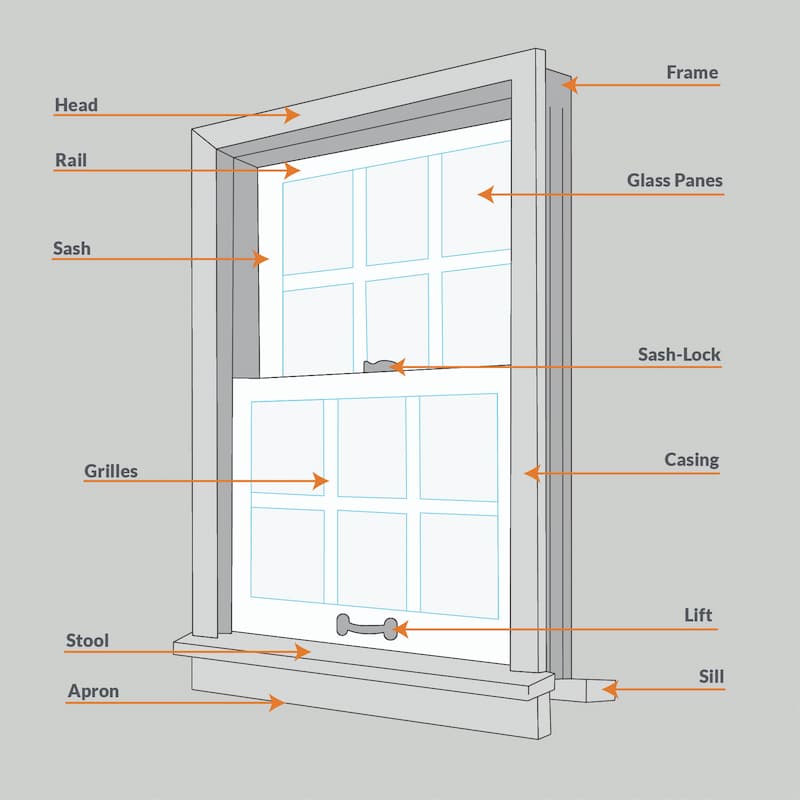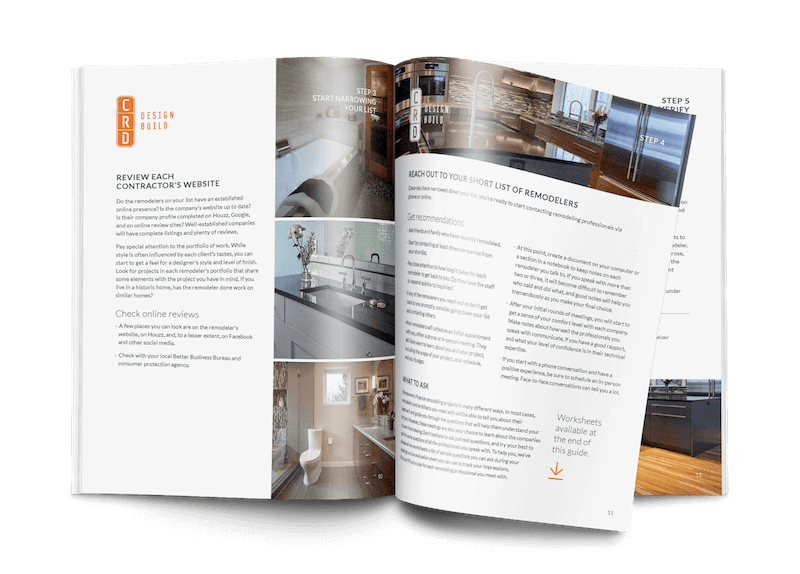Have you ever really looked out your windows beyond the view outside? While Windows might seem simple, they are actually many parts of a window that work together to provide light, insulation and aesthetics. If you’re shopping for windows or planning a remodel on your Seattle home, understanding key window terminology is essential. From sashes to frames to grilles, knowing these terms will help you communicate with your contractor and make the best choice for your home’s style and energy efficiency. See also: A Practical Guide to Window Placement
Anatomy of a Window: Key Components Every Homeowner Should Know
Common Window Parts

Contractors, manufacturers, and window installers seem to speak their own language when discussing windows.
Here are the definitions of parts of the window to help you cut through the jargon and understand the choices you have as a homeowner purchasing new windows.
Head
Within your window framework, the top most horizontal part is called the head. The head mirrors the sill at the bottom of your window frame and completes the window structure from above.
Rails
Rails are the horizontal structural pieces of the window. These include the lower rail, upper rail, and check rail which form the framework that holds window sashes in place.
Sashes
The sash refers to the part that holds the glass panes. Many windows consist of two sashes, an upper and a lower. Each of these contains its own glass panels and one or both can slide to open the window. In a single-hung window, the upper sash is stationary, while in the case of a double-hung window, you can lower and raise it for more air circulation. Both upper and lower sashes can have either a single windowpane or multiple panes. These panes are divided by grilles into two or more panels. Some windows have no grilles.
Grilles
As mentioned above, grilles are the vertical and horizontal decorative bars dividing your glass into four or more sections. They create the grid pattern you see on the glass. You find them on the inside of:
- single or double-hung windows
- bay and bow windows
You can paint them to match your interior design.
In traditional window design, each of these small frames held its own piece of glass. In most modern windows, the grid is just a set of faux frames that overlays a single glass panel.
Stool
The stool is the horizontal piece of trim sitting across your interior window frame on the bottom.
Apron
The vertically mounted interior trim piece located under the stool of your window is called an apron
Window Frame
The window frame is the casing that supports and engulfs your entire window framework and other window parts.
It’s the collective term for the window parts such as the top, the sill at the bottom, and the vertical elements called the jambs. Think of it as the window housing.
Glass Panes
The parts of the window you actually look through are called panes of glass. The glass panes might actually consist of two or three sealed layers of glass for more insulation, which is a major factor in your window's energy efficiency.
Sash Lock
The sash lock is a mechanism that allows you to lock your window.
Casing
The interior casing consists of trim pieces on each side of the window.
Lift
The lift is the handle you use to raise the lower window sash.
Sill
It’s the horizontal part sitting across your window frame on the exterior at the bottom. It mirrors the stool on the inside of your window.
Specialty Window Types Explained
Single- and Double-Hung Windows
These two window types remain the most popular among American homeowners. You can get them in wood, fiberglass, or vinyl materials. A double-hung window consists of two vertical sliding sashes, where you can either open the upper sash or bottom one for air circulation. A single-hung window has only one sliding sash: the bottom one.
Picture Windows
Picture windows are the simplest of all windows. They have no moving parts. These inoperable beauties tend to be large, and they are placed facing a pleasing outdoor space, like the backyard. Think of them as picture frames that focus the view.
Slider Windows
This is another simple window design. It features two sashes and the direction of opening is horizontal. Typically, only one sash slides, and the other is fixed, like a single-hung casement window, but both sashes can be designed to slide.
Casement Windows
A casement window offers a comfortable working mechanism. You open the window panels toward the inside or outside using hinges. Some casement windows open by pushing or pulling, and some have a cranking mechanism.
Exterior Parts of a Casement Window
- Casement — Do you see where the glass panel sits within the window, the part that you open for fresh air? Yes, it’s what we call the window casement.
- Stile — These are vertical parts of the casement.
Interior Parts of Casement Windows
- Mullion — The vertical bar that separates two casements is what you call the mullion in this type of window frame.
- Transom— On the other hand, the horizontal bar separating two casements goes by the name transom.
- Fanlight— A small window section above the main window that opens to provide ventilation.
- Hinges - They attach the sash to the window frame and allow for the window’s opening and closing. They are mainly two or three, depending on window height.
Box Sash Windows
If you live in an older Seattle home, you may have box sash windows. Instead of utilizing springs to make opening and closing easier, this type of window incorporate a weight-and-pulley system to balance out the weight of the window and make it easy to slide. A box sash window in good repair operates smoothly, but there are many parts (as you can see below), and it's important to keep them all in working order.
Common issues with box sash windows include accumulated layers of paint and broken sash cords, both of which impact functionality. You may be able to perform simple repairs and maintenance yourself, but for inoperable box sash windows, you may have to call in a repair person who specializes in this type of antique design.
 Source: Pxhere
Source: Pxhere
Exterior Parts of Box Sash Windows
- Window board— Commonly known as the window nosing in a window frame, they are fitted behind the bricks’ outer part.
- Top Rail— The horizontal bar across the top of the sash you open.
- Outer lining - Outer face of the window frame.
Interior Parts of a Box Sash Window
- Staff Bead— This is the molded bead that attaches to the inside lining holding the two sashes for smooth sliding.
- Architrave— It is the molding seen on the outermost edge of your window frame from the inside.
- Sash Cord - You find the cord attached to the sash weight in the box frame. It is fed through a pulley found on the window sides.
- Sash Bars— This separates the glass with more than one pane.
- Parting Bead— Vertical seal fitted into a box frame creating a channel for both upper and lower sash.
- Inside Lining— The inside faces on the head of the window frame.
- Stiles— This runs vertically on both surfaces of the sash lock.
- Bottom rail— It is the horizontal bar located over the bottom of the lower panel.
- Horn— The slight extension at the top stiles near the meeting rails to strengthen the joint.
Energy-Efficient Window Features
There is more to window units than its parts. Don't forget to consider energy savings and efficiency.
U Factor for Insulation
When selecting windows, be aware of the NFRC or EnergyStar label to make sure you're getting better quality windows. The U factor is important to make sure you have enough insulation. The lower the number, the less heat your windows will lose. Seattle requires less than 0.27 for the EnergyStar designation. A lower U factor makes for a more comfortable home and saves on your utility bills as well.
Low-E Coating
A low-E coating is an energy-efficient window coating that reflects the heat from the sun in the summer but lets it in when the sun's rays are weaker. In addition to being energy-efficient, low-E windows will reflect the light and allow you to enjoy your views more, without the heat transfer. These nearly invisible coatings can also help cool your home down by filtering harsh summer light during the heat of the day. Low-e coatings also help maintain a certain level of warmth during the winter months.
Double- and Triple-Pane Windows
Another great option is to choose dual-pane or triple-pane window glass for an added layer of insulation. Gas insulation is commonly used between the layers of glass in double pane windows to improve energy efficiency. Even if you have to spend more upfront, the energy savings will be worth it in the long run.
In conclusion, understanding the various parts of a window can help you make informed decisions during a renovation or replacement project. Each element, from the sash to the frame, plays a role in enhancing your home’s insulation, comfort and overall aesthetic. Hiring a professional window installer is essential to ensure proper window alignment, insulation and weather resistance. Additionally, a quality installation is key to reducing noise, air leakage and maintaining comfort year-round. By investing in expertise, you’ll enjoy windows in your Seattle home that will perform beautifully for years to come.
See also: Window Replacement 101: The Essential Guide for Beginners
Guide to Hiring a Remodeler
This comprehensive guide walks you through all the steps of choosing who will design and build your project, vetting remodeling companies, and ensuring that you have the best experience.





